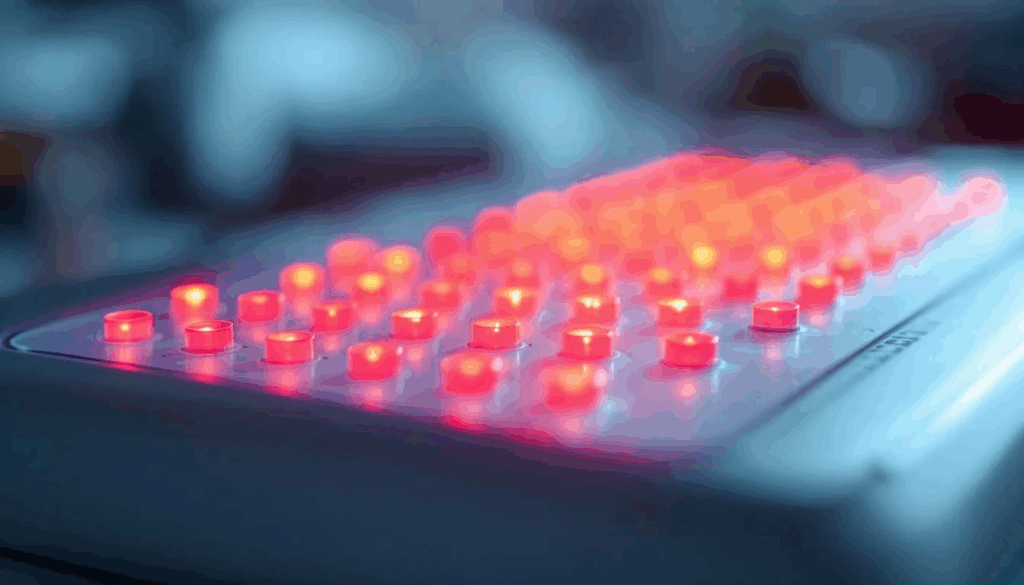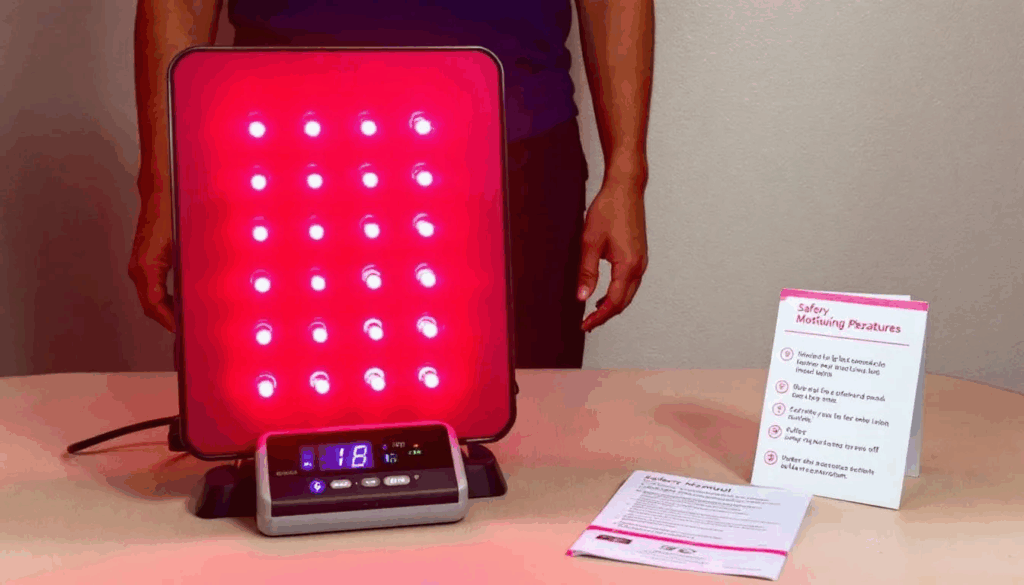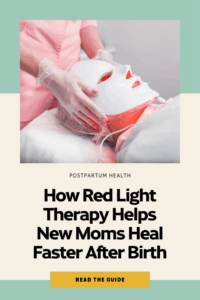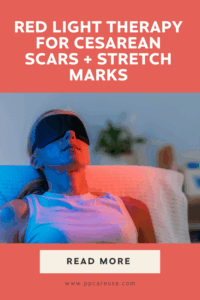Red light therapy during postpartum offers a safe, non-invasive treatment option that supports new mothers through the unique physical and emotional challenges that can last for months or even years after childbirth. While traditional recovery methods focus primarily on rest and medication, an increasing number of new moms are discovering the benefits of this innovative healing approach.
Red light therapy, also called photobiomodulation, uses specific wavelengths of light to stimulate the body’s cells at a cellular level, promoting faster healing and reducing inflammation. This innovative therapy has gained significant attention in recent years, with clinical trials demonstrating its effectiveness for everything from wound healing to mental health support.
In this comprehensive guide, we’ll explore how light therapy for postpartum recovery can transform your healing experience, providing you with the knowledge needed to make informed decisions about incorporating this treatment into your wellness routine.

What Is Red Light Therapy?
Red light therapy is a non invasive treatment that uses specific wavelengths of light to stimulate cellular function and promote healing throughout the body. This therapy utilizes LED devices or low-level lasers to deliver concentrated light energy directly to the treated area, penetrating deep into tissues without causing heat or damage.
The therapy works by delivering specific wavelengths of red light and near infrared light to the skin and underlying tissues. Unlike blue light, which primarily affects surface-level concerns, red light devices penetrate deeper into the body to reach muscles, joints, and other tissues that need healing support after childbirth.
Many red light therapy devices available today are FDA-cleared for home and clinical use, providing new moms with convenient access to this technology. Options range from handheld units and red light therapy mask designs to larger panels that can treat multiple areas simultaneously. These devices have evolved significantly since the therapy’s origins in medical applications during the 1960s.
The growing popularity of red light therapy among postpartum mothers stems from its versatility and safety profile. Unlike many treatments available during the postpartum period, red light treatment doesn’t interfere with breastfeeding or require downtime, making it an attractive option for busy new moms seeking to support their recovery naturally.
How Does Red Light Therapy Work for Postpartum Recovery?
The science behind red light therapy lies in its ability to interact with mitochondria, the powerhouses of our body’s cells. When red light and near infrared light penetrate the skin, they are absorbed by chromophores within cellular mitochondria, particularly an enzyme called cytochrome c oxidase. This absorption triggers a cascade of beneficial cellular processes that support postpartum healing.
The primary mechanism involves boosting adenosine triphosphate (ATP) production, which serves as the energy currency for all cellular functions. Enhanced ATP production provides cells with the energy needed for repair and regeneration, making it particularly valuable during the demanding postpartum recovery period when the body is working to heal from childbirth.
Red light therapy also stimulates collagen production, a crucial protein responsible for tissue repair and skin elasticity. This increased collagen synthesis helps restore skin tone and supports the healing of various tissues affected during pregnancy and delivery, from stretched abdominal skin to healing cesarean scars.
The therapy significantly increases blood circulation and promotes the growth of new blood vessels in the treated area. This enhanced blood flow delivers oxygen and nutrients more efficiently to healing tissues while removing waste products that can slow recovery. The improved circulation also helps reduce inflammation at the cellular level, addressing one of the key factors that can prolong postpartum discomfort.
The low level wavelengths used in red light therapy penetrate through multiple skin layers to reach deeper tissues, including muscles, joints, and organs. This deep penetration allows the therapy to support tissue healing throughout the body, making it effective for addressing the comprehensive physical changes that occur during the postpartum period.

How Long Should You Use Red Light Therapy Postpartum?
The optimal treatment duration for red light therapy sessions is typically 10-20 minutes per treated area. This timeframe allows sufficient light energy to penetrate tissues and stimulate cellular function without overwhelming the body’s natural healing processes. New moms should start with shorter sessions and gradually increase duration as they become comfortable with the treatment.
For frequency recommendations, most experts suggest 3-5 sessions per week for best results. This schedule provides consistent light exposure while allowing the body time to respond to each treatment. Some women prefer daily sessions, particularly during the initial weeks of recovery when inflammation and discomfort may be most pronounced.
The timeline for visible results varies depending on the specific concern being addressed. Initial improvements in pain relief and energy levels may be noticed within 2-4 weeks of consistent use, while more significant improvements in scar appearance, skin tone, and overall recovery typically become apparent after 8-12 weeks of regular sessions.
Red light therapy is considered safe to use throughout the entire postpartum period, which can extend from 6 weeks to 2+ years after delivery. Unlike many treatments that have restrictions during breastfeeding or early recovery, light therapy may be incorporated immediately after clearance from your healthcare provider, typically around 1-2 weeks postpartum for external use.
After the initial recovery phase, many women transition to a long-term maintenance schedule of 2-3 sessions per week. This ongoing approach helps support continued healing while maintaining the benefits achieved during the more intensive initial treatment period. The flexibility of red light devices makes it easy to adjust treatment frequency based on individual needs and lifestyle demands.
At Postpartum Care USA, we use and LOVE Lumebox. Use code PPCAREUSA for a discount!

Red Light Therapy Postpartum Benefits
Let’s talk about some of the benefits of red light specifically for postpartum physical and mental health.
1. Accelerated Wound and Scar Healing
One of the most significant benefits of red light therapy for new moms is its ability to promote faster healing of surgical incisions and natural tears. The therapy stimulates cellular repair mechanisms that are essential for proper wound healing, making it particularly valuable for women recovering from cesarean sections or dealing with perineal tears.
Research has consistently demonstrated the effectiveness of light therapy in reducing healing time and improving scar appearance. A notable 2013 study published in the journal of clinical and aesthetic dermatology showed significant improvements in surgical scar appearance among patients who received red light treatment compared to those who received standard care alone.
For cesarean scars specifically, red light therapy helps reduce scar tissue formation while promoting healthy collagen alignment. This results in scars that are flatter, less noticeable, and more flexible over time. The therapy’s ability to support tissue healing extends beyond fresh incisions to benefit older surgical scars as well, making it valuable for women who experienced complications or delayed healing.
The treatment also provides substantial benefits for women recovering from perineal tears, which affect up to 90% of first-time mothers. By promoting faster healing and reducing inflammation in this sensitive area, red light therapy can significantly decrease discomfort and support a faster return to normal activities.
2. Pain Relief and Inflammation Reduction
Postpartum pain affects virtually all new mothers, whether from surgical recovery, natural delivery trauma, or the physical demands of caring for a newborn. Red light therapy provides effective pain relief through multiple mechanisms, including reducing inflammation and improving blood flow to affected areas.
The therapy is particularly effective for addressing postpartum back pain, which commonly develops from carrying a growing baby, delivery positioning, and the repetitive motions of nursing and infant care. By reducing inflammation in muscles and joints while promoting tissue repair, red light treatment can provide lasting relief rather than temporary symptom masking.
Women experiencing chronic pain conditions that may be exacerbated during the postpartum period also benefit from the therapy’s pain-modulating effects. The treatment works by inhibiting pro-inflammatory mediators and enhancing local blood circulation, addressing pain at its source rather than simply blocking pain signals.
For breastfeeding mothers, red light therapy can help alleviate breast pain and discomfort associated with engorgement, blocked ducts, or mastitis symptoms. The therapy’s anti-inflammatory properties, combined with its ability to improve circulation, make it a valuable tool for maintaining breast health during the nursing period.
Unlike pharmaceutical pain management options that may have restrictions during breastfeeding, red light therapy offers a safe, drug-free alternative that can be used as frequently as needed without concerns about affecting milk supply or infant safety.
3. Skin Health and Stretch Mark Improvement
The dramatic physical changes of pregnancy and childbirth often leave lasting effects on skin appearance, from stretch marks to changes in skin tone and texture. Red light therapy addresses these concerns by stimulating collagen production and promoting skin rejuvenation at the cellular level.
Stretch marks, which affect up to 90% of pregnant women, develop when skin is stretched beyond its elastic capacity, causing tears in the dermis. Red light therapy helps improve the appearance of both new and existing stretch marks by promoting collagen synthesis and improving skin elasticity. While complete elimination of stretch marks isn’t realistic, many women see significant improvements in color, texture, and overall appearance.
The therapy also addresses postpartum acne and other hormonal skin changes that commonly occur during recovery. By reducing inflammation and supporting healthy skin cell turnover, red light treatment can help restore clearer, more balanced skin tone as hormone levels stabilize.
FDA-cleared devices have demonstrated measurable improvements in skin health after 3 months of consistent use. These benefits extend beyond cosmetic improvements to include enhanced skin barrier function and improved overall skin health, which can be particularly beneficial during the postpartum period when skin may be more sensitive or reactive.
The skin rejuvenation effects of red light therapy also benefit areas of aging skin that may have been accelerated by pregnancy hormones or the stress of caring for a newborn. By supporting cellular renewal and collagen production, the therapy helps maintain healthy, youthful-looking skin during this demanding life phase.
4. Enhanced Energy and Cognitive Function
Postpartum fatigue is one of the most challenging aspects of new motherhood, often persisting long after physical recovery is complete. Red light therapy addresses this concern by boosting mitochondrial function throughout the body, leading to increased cellular energy production and improved overall energy levels.
The therapy’s effect on ATP production directly impacts how energized women feel during their daily activities. By optimizing cellular function, red light treatment can help combat the exhaustion that comes from sleep disruption, hormonal changes, and the physical demands of caring for an infant.
Cognitive function, often referred to as “baby brain,” is another area where red light therapy shows promise. A 2021 study demonstrated significant improvements in cognitive function among participants who received daily 6-minute red light therapy sessions. These improvements included better focus, enhanced memory, and clearer thinking – all crucial for managing the complex demands of new motherhood.
The enhanced cellular function promoted by red light therapy also supports the body’s ability to cope with stress, which is elevated during the postpartum period. By improving the efficiency of cellular energy production, the therapy helps the body maintain better resilience in the face of physical and emotional challenges.
For women returning to work after maternity leave, these cognitive and energy benefits can be particularly valuable in supporting a successful transition back to professional responsibilities while maintaining the demands of motherhood.
5. Mood and Sleep Support
The postpartum period brings significant hormonal fluctuations that can affect mood stability and sleep quality. Red light therapy helps regulate circadian rhythms, which are crucial for maintaining healthy sleep-wake cycles that often become disrupted after childbirth.
Research suggests that light therapy may help increase production of serotonin and dopamine, neurotransmitters that play crucial roles in mood regulation and feelings of well-being. While more research is needed to fully understand these mechanisms, many women report improved mood and greater emotional stability when using red light therapy consistently.
For women at risk of or experiencing postpartum depression, light therapy may offer valuable support as part of a comprehensive treatment approach. Studies in the field of clinical psychiatry have explored light therapy’s potential benefits for mood disorders, though it’s important to note that red light therapy should complement, not replace, professional mental health care when needed.
The therapy’s ability to promote relaxation and stress reduction through cortisol regulation can also support better sleep quality. By helping the body maintain more balanced stress hormone levels, red light treatment may make it easier to achieve restorative sleep during the brief windows available between infant feedings.
Improved sleep quality, in turn, supports better mood regulation, creating a positive cycle that benefits overall mental health during the challenging postpartum adjustment period.
Safety Considerations and Device Selection
Choose a Reputable Brand
When selecting red light devices for postpartum use, it’s essential to choose FDA-cleared products from reputable manufacturers. These devices have undergone testing to ensure they meet safety standards and deliver the specific wavelengths and power densities necessary for therapeutic benefits. Don’t just grab the first one you find on Amazon or TikTok!
Look for devices that offer both 660nm and 850nm wavelengths, as this combination provides optimal penetration depth and therapeutic effects. The 660nm wavelength primarily benefits skin-level concerns, while 850nm near infrared light penetrates deeper to reach muscles, joints, and other tissues requiring support during postpartum recovery.
Choose a Device Suited for Your Needs
Consider portable, TSA-approved options for maximum convenience and flexibility in your treatment routine. Some women prefer red light therapy mask designs for facial treatments, while others benefit from larger panels that can treat multiple areas simultaneously. Handheld devices offer targeted treatment for specific concerns like cesarean scars or localized pain.
Consult with Your Healthcare Provider
Before beginning any new treatment during the postpartum period, consult with your healthcare provider, especially if you’re breastfeeding. While red light therapy has no known contraindications for nursing mothers, your doctor can provide personalized guidance based on your specific recovery needs and any complications you may be experiencing.
Current research shows no evidence linking red light therapy to cancer risks or other serious adverse effects when used as directed. The therapy is considered one of the safest treatment modalities available for postpartum recovery, with the most common side effects being temporary warmth or mild redness in the treated area.
Protect Your Eyes
Always avoid looking directly into LED lights during treatment to protect your vision. Most quality devices include safety features and clear usage instructions to minimize any risk of improper use.

Will Red Light Therapy Help Me Recover Faster Postpartum?
Scientific evidence consistently supports red light therapy’s ability to accelerate wound healing and reduce pain during postpartum recovery. Multiple clinical trials have demonstrated faster healing times for surgical incisions, reduced inflammation markers, and improved overall recovery outcomes when red light treatment is incorporated into postpartum care.
However, it’s important to maintain realistic expectations about the timeline and extent of improvements. Red light therapy promotes gradual healing over 8-12 weeks rather than providing immediate dramatic changes. The therapy works by optimizing your body’s natural healing processes, which means results develop progressively as cellular function improves.
Best results occur when red light therapy is combined with proper nutrition, adequate rest, and appropriate medical care. The therapy should be viewed as a valuable addition to a comprehensive postpartum recovery plan rather than a standalone solution for all recovery challenges.
Individual results vary based on factors including overall health status, consistency of use, and the specific concerns being addressed. Women who use their devices consistently according to manufacturer recommendations typically see more significant improvements than those who use treatments sporadically.
As a safe, non invasive addition to your postpartum recovery plan, red light therapy offers the advantage of supporting healing without interfering with other treatments or medications you may be using. This compatibility makes it an excellent option for women seeking to optimize their recovery using multiple approaches.
The therapy’s effects extend beyond physical healing to support overall wellness during the postpartum period. By addressing multiple aspects of recovery – from pain relief to energy enhancement – red light therapy can help new mothers feel more like themselves during this transformative time.
Conclusion
Red light therapy offers new mothers a scientifically-backed, safe approach to supporting postpartum recovery across multiple dimensions. From accelerating wound healing and reducing pain to supporting energy levels and potentially improving mood, this non invasive treatment addresses many of the challenges women face during the postpartum period.
Remember that every woman’s postpartum journey is unique, and what works best for one mother may differ for another. Always consult with your healthcare provider before beginning red light therapy to ensure it’s appropriate for your specific situation and recovery needs.
Taking time for self-care through treatments like red light therapy isn’t just beneficial for you – it’s an investment in your ability to care for your family. When you feel better physically and emotionally, you’re better equipped to handle the demands of motherhood while enjoying this special time with your new baby.
Ready to explore how red light therapy can support your postpartum recovery? Start by discussing this option with your healthcare provider and researching FDA-cleared devices that fit your needs and lifestyle. Your journey to optimal postpartum healing begins with taking that first step toward prioritizing your own health and wellbeing.
At Postpartum Care USA, we use and LOVE Lumebox. Use code PPCAREUSA for a discount!
Pin This For Later



Postnatal Depletion
Meet the Team
Our Services
Supplements
A virtual healthcare clinic that helps postpartum mamas recover from postnatal depletion syndrome with a holistic approach.

Get in touch